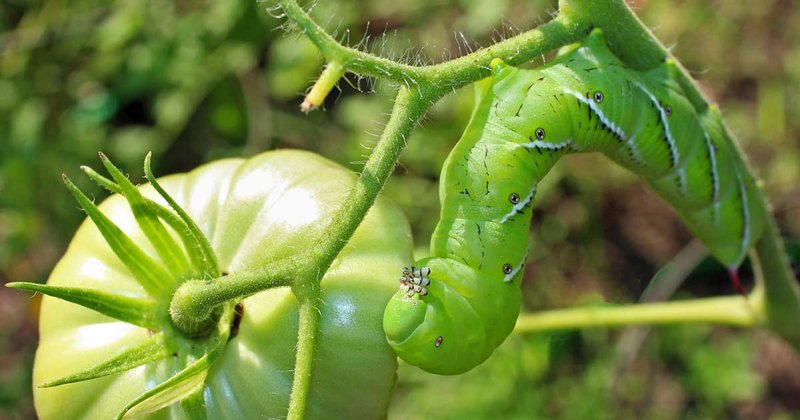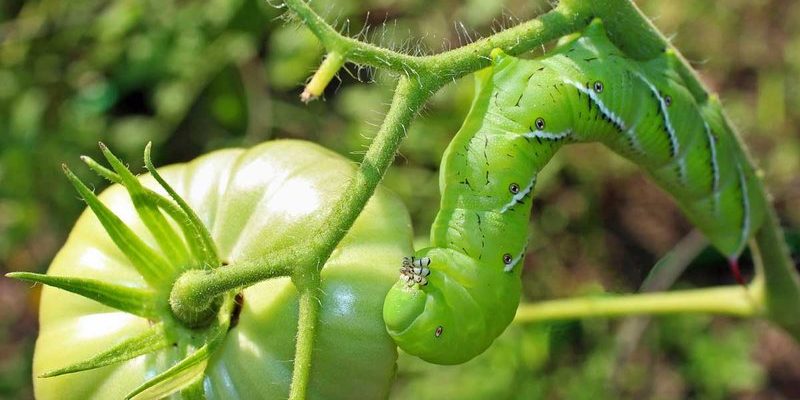
So, how do you spot these pesky intruders? Identifying tomato hornworms early is key to keeping your garden healthy. It’s kind of like being a detective in your own backyard. You’ll want to know what they look like, where to find them, and how to deal with them. In this guide, we’ll explore everything you need to know about spotting tomato hornworms, keeping them at bay, and protecting your beloved tomato plants.
What Are Tomato Hornworms?
Tomato hornworms are the larvae of the Five-spotted Hawk Moth. These greenish caterpillars can grow to about 4 inches long and are notorious for their voracious appetite. Simply put, they can devour leaves and even entire tomatoes in a matter of days. Their color helps them blend in with the foliage—making them even harder to spot. Imagine trying to find a green crayon on a green piece of paper!
You might be wondering, why are they called hornworms? It’s because they have a horn-like structure on their rear end. While this might look intimidating, it’s harmless. However, if you see these little guys on your plants, it’s time to take action before they do some serious damage. Remember, the earlier you identify them, the easier it is to manage the problem.
How to Identify Tomato Hornworms
Identifying tomato hornworms can be tricky, but here are some telltale signs you shouldn’t miss:
- Color and Size: As mentioned, they are typically green but can also have a slight bluish tint. They are about 3-4 inches long, so if you find a sizable caterpillar munching away, it might just be a hornworm.
- Damage to Plants: If your tomato plants look like someone took a bite out of them, check for these sneaky invaders. Hornworms love devouring the leaves and can strip a plant bare.
- Droppings: Look for small droppings on the leaves or ground underneath your plants. These black or dark green pellets are a good sign that hornworms are nearby.
Once you know what to look for, spotting these pests becomes easier. Keep in mind that hornworms may not always be visible during the day since they like to hide. A good tip is to check your plants in the early morning or evening when they are more active.
Where to Look for Tomato Hornworms
If you’re on the hunt for tomato hornworms, knowing where to look is half the battle. These pests tend to hang out in a few specific places:
- On the Leaves: They love to munch on leaves, particularly the larger, older ones. Check the undersides of leaves where they love to hide.
- Near the Tomato Fruits: If you have tomatoes ripening, keep an eye out for hornworms near these areas, as they often chew on fruits as well.
- Among the Weeds: Hornworms can also be found in nearby weeds or other plants like peppers and eggplants. If you have a garden full of various veggies, do a thorough check!
Being proactive about your inspection will save you heartache later. You don’t want to discover a significant infestation too late in the season!
Natural Ways to Control Tomato Hornworms
If you do find hornworms in your garden, don’t fret! There are plenty of natural ways to control these pests without resorting to harsh chemicals. Here are a few effective methods:
- Handpicking: This is probably the simplest method. Just wear some gloves and manually remove the hornworms from your plants. After you’ve collected them, you can either relocate them far away or dispose of them humanely.
- Beneficial Insects: Encourage natural predators to your garden, like parasitic wasps. These tiny wasps lay their eggs in hornworms, and when the larvae hatch, they’ll consume the hornworm from the inside out—quite the dramatic twist!
- Neem Oil: This natural pesticide can disrupt the feeding patterns of hornworms. Spray neem oil on your plants, but be sure to follow the directions carefully to avoid harming beneficial insects.
Trying these methods can be a great way to keep your garden healthy while minimizing harm to the ecosystem.
Chemical Control Options
If things are really out of control and natural methods aren’t cutting it, you might consider chemical options. However, it’s essential to use these wisely:
- Insecticidal Soaps: These are less harmful and can help target hornworms without affecting beneficial insects. Just make sure to apply them thoroughly to cover the worms.
- Bacillus thuringiensis (Bt): This is a natural bacterium that’s effective against caterpillars. When ingested, it disrupts their ability to digest food, leading to their demise. Make sure you apply it during the active feeding period.
- Conventional Insecticides: While effective, these should be a last resort due to the potential harm to beneficial insects and the environment. Always read labels and follow instructions to the letter.
Before jumping into chemical control, weigh the pros and cons. It’s vital to prioritize health and safety for you, your pets, and the environment.
Preventing Tomato Hornworm Infestations
Once you’ve dealt with hornworms, it’s crucial to take steps to prevent their return. Here are some strategies to keep these pests at bay:
- Crop Rotation: Switch up where you plant your tomatoes each season. This tricks pests into losing track of their favorite snack!
- Maintain Healthy Plants: Strong plants are less susceptible to pests. Make sure your tomatoes have adequate water, fertilizer, and sunlight.
- Companion Planting: Include plants that repel hornworms, such as marigolds or basil, among your tomato plants. This can confuse pests and keep them from finding their way to your tomatoes.
Being proactive in your garden will not only save your tomatoes but also enhance your gardening experience.
Final Thoughts on Tomato Hornworms
Identifying tomato hornworms in your vegetable garden may seem daunting at first, but with some knowledge and awareness, you can protect your plants. Remember, early detection is your best friend. Regularly inspect your tomato foliage, look for signs of damage, and don’t hesitate to take action if you spot these little creatures.
Gardening is all about trial and error, and dealing with pests is just one part of the journey. By using both natural and chemical control methods, alongside prevention tactics, you can enjoy a bountiful tomato harvest this year. Now it’s time to get out there and enjoy your garden—just keep an eye out for those sneaky hornworms!

